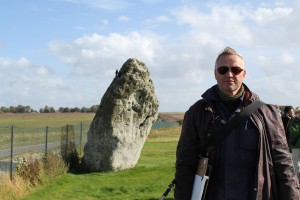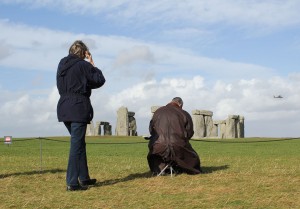Stonehenge – Wednesday 17th October
It’s more than windy today. It’s gale-like. But still, the artist Mark Anstee is determined that since it isn’t raining, he can get a couple of hours drawing in at Stonehenge.
As we walk over the low metal bridge I see jackdaws sheltering from the harsh wind, clinging to jackdaw sized footholds in the Heel Stone.
Mark needs to draw at 360° or 0°, the beginning and end of the circle. Immediately we arrive at the spot I am asked by a sweet couple if I’ll take a photo for them in front of Stonehenge. It’s so windy I find it a challenge keeping their small compact camera still as I take the photo. They’re visiting from Los Angeles and have to run off because they’re part of a coach tour and their allotted time is short. I watch them hold hands and gallop off round the walkway. They could clearly do with more time here.
I hear more American accents; Spanish and German being spoken, but the wind is dominating the soundscape, closely followed by the traffic on the A303 and of course, helicopters. On days like today, Stonehenge feels like one of the noisiest places on the planet.
Mark sits up close to the guide rope, his drawing board on his lap.
The guide rope as I call it, the ‘fence’ or ‘barrier’ as I’ve heard it called by visitors, is really a massive ‘Standoff’. Standoff is the name given to temporary barriers set up in art galleries to stop the viewer from going any further, getting any closer to a painting or sculpture. They’re usually about shin or knee height, so as not to impede the view of the art work and are generally neutral in tone, in temporary exhibitions maybe brushed aluminium uprights holding a grey cord horizontally to form the flimsiest of barriers.
I asked Mark about this idea of the guide rope enclosing Stonehenge as a Standoff:
Mark: Yes. It’s a Standoff which is pertinent to the kind of structure. So in galleries, you get nice, little, finely crafted ones with fine wires and all very neat and beautiful, and here, it’s a kind of climbing rope with stakes driven into the ground.
Gabi: I suppose aesthetically it goes. It’s very appropriate to the landscape and the open air.
Mark: Absolutely. According to the context of the building or the monument or the precious object, the Standoff also has a direct relationship in terms of an aesthetic and maybe the atmosphere it’s in, and how people are expected to be in that landscape or that environment.
Gabi: Do you think they’re protecting the stones or the grass?
Mark: That’s a funny idea. When you have a toy soldier they have their own little bit of grass and often a snow-dome or something, has its own little bit. The rope does move slightly to protect the grass from people trampling in the same area again and again, but ostensibly, there is a kind of forbidden zone, a kind of ‘aura’ of grass around the monument itself which is a physical and visual thing. So you get this kind of ‘distance’ from this fantastic iconic monument.
Gabi: Do you find it frustrating that you can’t get closer?
Mark: Personally, no. I like the aura. That distance gives something. Like when you have those views of the Taj Mahal or the Great Sphinx or the Pyramids at a distance. To have people crawling all over it would reduce its status. I think there is a frustration in people that they would love to get close and see and feel and capture some of its essence. But at the same time, they’d be very disappointed if they couldn’t get that nice picture within a particular frame, which is the clean shot!

